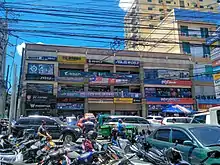Gilmore Avenue, Quezon City
Gilmore Avenue is a main road in Quezon City, Metro Manila, the Philippines. It runs one-way from Eulogio Rodriguez Sr. Avenue in New Manila and terminates at Nicanor Domingo Street in Valencia, continuing on as the two-way Granada Street until it reaches the city border with San Juan, where it becomes Ortigas Avenue. The road is named for Eugene Allen Gilmore, Vice Governor-General of the Philippines from 1922 to 1929 who twice served as acting Governor-General.[2]
.svg.png.webp)  | |||
|---|---|---|---|
 Gilmore Avenue, looking south from its intersection with 12th Street | |||
| Former name(s) |
Governor Gilmore Street Gilmore Street | ||
| Namesake | Eugene Allen Gilmore | ||
| Maintained by | Department of Public Works and Highways | ||
| Length | 1.476 km[1] (0.917 mi) | ||
| Component highways |
| ||
| Location | Quezon City | ||
| North end | Eulogio Rodriguez Sr. Avenue | ||
| Major junctions | |||
| South end |
Nicanor Domingo Street Granada Street | ||
The one-way, two-lane road segment from Eulogio Rodriguez Sr. Avenue to Aurora Boulevard within New Manila is notorious for many vehicular accidents, with an average of 0.1 to 0.3 accidents per day. Many of these accidents are attributed towards overspeeding as a result of the wide single-direction lane width, and due to poor visibility during night time.[3]
History
Gilmore Avenue was originally named and constructed sometime before 1943 as Governor Gilmore Street, serving as one of four north-south thoroughfares for the New Manila Subdivisions established a few decades prior. It served as a one-way southbound counterpart to the one-way northbound Pacific Avenue (now Doña Hemady Avenue),[4][5] which was originally named as a reference to America’s successful acquisition of the Pacific Rim islands that included the Philippines during the Spanish–American War in 1898.[6]
South of the New Manila area, new subdivisions and a shopping center were being developed in what would become the Greenhills area in the municipality of San Juan del Monte, Rizal (now San Juan City, Metro Manila) in the 1960s and 1970s, [7] and so the road became known as a passageway for motorists to Greenhills and Ortigas Avenue itself.[8]
Commercial development
The Greenhills Shopping Center became known as a hub for computer parts and accessories at affordable prices for computer hobbyists and IT enthusiasts alike until the computer boom in the 1990s made computers mainstream and increased the demand for computer retail markets. As the Greenhills Shopping Center had become too crowded for the increasing demand of the computer boom, a computer retail store owner in 1997 decided to set up shop along the once-desolate Gilmore Avenue.[8][9]
The first computer retail store to open in the area was PC Options, which contrary to popular belief, the "PC" in the name does not actually refer to personal computers, but rather, coincidentally was the initials of the shop's founder and owner.[8][9] As the area was being developed commercially, PC Options became popular for pioneering the do-it-yourself concept for computer customizations in the local market, serving as the catalyst for other computer retail shops to open in the area.[8][9]
As several computer shops in Greenhills had to close down due to renovations at the shopping center itself, Gilmore became established as a major IT hub in Metro Manila, with the Gilmore name becoming synonymous to computer retail.[8]
Landmarks

The Quezon Heritage House, built in the 1920s, is located along the avenue. Saint Paul University Quezon City is also located on Gilmore Avenue corner of Aurora Boulevard. The office of SYKES Asia Inc. at K Pointe Building is located just opposite of St. Paul. Broadway Centrum is also located within the vicinity.
Computer and IT hub
The Aurora Boulevard intersection of Gilmore Avenue is a popular hub for IT-related products and services for computers and related components. Both the southern corners of Gilmore and Aurora roads are filled with stores selling different kinds of computers and their accessories, both secondhand and brand-new.[10]
Transport
Bus Route 11 (Gilmore-Taytay) serves the commercialized section of Gilmore Avenue, with its northern namesake terminus being located at the intersection of Gilmore Avenue and Nicanor Domingo Street.[11] It is also served by Bus Route 10 (Doroteo Jose-Cubao), which stops at the intersection of Gilmore Avenue and Aurora Boulevard.[12]
The nearest mass transport station from Gilmore Avenue is the Gilmore station of the Manila LRT Line 2, which was named after the road itself, and the future N. Domingo station of the MRT-4 monorail line.
References
- "Road and Bridge Inventory". Department of Public Works and Highways. Retrieved March 13, 2022.
- Alcazaren, Paulo (January 4, 2014). "Origins of Metro Manila". The Philippine Star. PhilStar Daily, Inc. Archived from the original on January 6, 2014. Retrieved February 12, 2018.
- Road Crash Statistics along Gilmore Avenue in Quezon City 2005-2021. TEC-RSU-RCR-22-186 to 220. Freedom of Information Philippines: Metropolitan Manila Development Authority. 2022.
- Map of Manila and Suburbs (Map). 1:20,000. The Chief of Engineers, Washington, D.C. 1943. Retrieved March 13, 2022.
- Manila North, Philippine Islands, Manila City, Luzon (Map). 1:12500. Its A.M.S. S901. United States. United States. Army Map Service. 1945.
- Ysmael, Rosary (December 19, 2020). "Doña Hemady—my great grand 'lola', not the street". The Diarist.ph. Retrieved March 13, 2022.
- "Ortigas & Company". 2016-10-28. Archived from the original on October 28, 2016. Retrieved 2021-12-20.
- "The "IT hub" in Gilmore Avenue". The Urban Roamer. 2012-10-06. Retrieved 2021-12-20.
- "PC Options -> About Us". www.pcoptionsph.com. Retrieved 2021-12-20.
- News, Mark Demayo, ABS-CBN (2020-05-30). "Laptop demand soars". ABS-CBN News. Retrieved 2021-10-04.
- "Resolution No. 71 Series of 2020" (PDF). Land Transportation Franchising and Regulatory Board. May 27, 2020. Retrieved January 10, 2022.
- "Resolution No. 109 Series of 2020" (PDF). Land Transportation Franchising and Regulatory Board. June 11, 2020. Retrieved January 10, 2022.
| Wikimedia Commons has media related to Gilmore Avenue, Quezon City. |